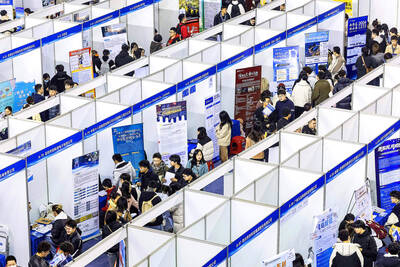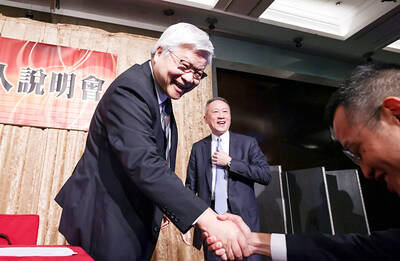China’s factory-gate prices fell for a record 32nd month and consumer prices remained subdued last month, raising pressure on policymakers to bolster the world’s second-largest economy as disinflation spreads.
The producer-price index (PPI) dropped 2.2 percent from a year earlier, the National Bureau of Statistics said in Beijing yesterday, compared with the median projection of a 2 percent decline in a survey of analysts by Bloomberg News.
Consumer prices rose 1.6 percent and the rate was unchanged from the prior month and matched economists’ estimates.

Photo: AFP
China’s economy, burdened by overcapacity and weak domestic demand, is headed for the slowest full-year growth in more than two decades. Lower oil and metals prices are cutting costs at the factory gate, allowing China’s exporters to reduce prices and adding to deflationary pressures globally.
“China’s domestic demand remained soft and disinflationary risks are on the rise on the back of falling global commodity prices,” said Chang Jian (常健), chief China economist at Barclays PLC in Hong Kong. “Subdued inflation offers room for more PBOC [People’s Bank of China] easing, but broad-based monetary easing will more likely to be triggered by disappointing growth numbers, which we will likely see in the coming months.”
Chang said she expects the PPI drop to continue next year.
Purchasing prices of fuels fell 3.8 percent last month from a year earlier, while ferrous metals costs dropped 6.9 percent, bureau data showed. Prices of all nine components dropped.
Oil prices have slumped into a bear market amid speculation of a global glut, slowing drilling at US shale formations. OPEC nations are responding by cutting prices, resisting calls to reduce supply as they compete with the highest US output in three decades.
“The extended drop in the PPI is affected by the prolonged decline of global oil prices and overcapacity in some domestic industries,” Yu Qiumei (余秋梅), a senior statistician at the bureau, said in a statement yesterday.
Eighteen of China’s 31 provinces and municipalities reported a nominal growth rate lower than the price-adjusted level for the first nine months of this year, signaling deflation. China’s import growth moderated to 4.6 percent last month from September’s 7 percent gain, according to data released by China’s General Administration of Customs over the weekend.
“China has entered into a disinflation process with rising deflation risk,” analysts at Australia & New Zealand Banking Group Ltd (ANZ) in Hong Kong led by Liu Li-Gang (劉利剛) wrote in a note yesterday. “This is a significant risk facing China’s economy, which requires China’s policy makers to monitor the situation closely and take actions swiftly.”
The central bank could conduct liquidity injections via different policy instruments more frequently, while fiscal policy will be “proactive,” the ANZ analysts wrote.
The People’s Bank of China, which has refrained from across-the-board interest rate cuts, confirmed liquidity injections into banks in the third quarter in a report last week. It also cut the interest rate it pays lenders for 14-day repurchase agreements in September and last month.

Stephen Garrett, a 27-year-old graduate student, always thought he would study in China, but first the country’s restrictive COVID-19 policies made it nearly impossible and now he has other concerns. The cost is one deterrent, but Garrett is more worried about restrictions on academic freedom and the personal risk of being stranded in China. He is not alone. Only about 700 American students are studying at Chinese universities, down from a peak of nearly 25,000 a decade ago, while there are nearly 300,000 Chinese students at US schools. Some young Americans are discouraged from investing their time in China by what they see

MAJOR DROP: CEO Tim Cook, who is visiting Hanoi, pledged the firm was committed to Vietnam after its smartphone shipments declined 9.6% annually in the first quarter Apple Inc yesterday said it would increase spending on suppliers in Vietnam, a key production hub, as CEO Tim Cook arrived in the country for a two-day visit. The iPhone maker announced the news in a statement on its Web site, but gave no details of how much it would spend or where the money would go. Cook is expected to meet programmers, content creators and students during his visit, online newspaper VnExpress reported. The visit comes as US President Joe Biden’s administration seeks to ramp up Vietnam’s role in the global tech supply chain to reduce the US’ dependence on China. Images on

New apartments in Taiwan’s major cities are getting smaller, while old apartments are increasingly occupied by older people, many of whom live alone, government data showed. The phenomenon has to do with sharpening unaffordable property prices and an aging population, property brokers said. Apartments with one bedroom that are two years old or older have gained a noticeable presence in the nation’s six special municipalities as well as Hsinchu county and city in the past five years, Evertrust Rehouse Co (永慶房產集團) found, citing data from the government’s real-price transaction platform. In Taipei, apartments with one bedroom accounted for 19 percent of deals last

US CONSCULTANT: The US Department of Commerce’s Ursula Burns is a rarely seen US government consultant to be put forward to sit on the board, nominated as an independent director Taiwan Semiconductor Manufacturing Co (TSMC, 台積電), the world’s largest contract chipmaker, yesterday nominated 10 candidates for its new board of directors, including Ursula Burns from the US Department of Commerce. It is rare that TSMC has nominated a US government consultant to sit on its board. Burns was nominated as one of seven independent directors. She is vice chair of the department’s Advisory Council on Supply Chain Competitiveness. Burns is to stand for election at TSMC’s annual shareholders’ meeting on June 4 along with the rest of the candidates. TSMC chairman Mark Liu (劉德音) was not on the list after in December last